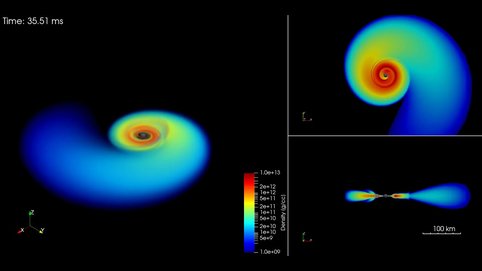Models for binary black hole – neutron star mergers
Numerical simulations reveal details of the coalescence
When black holes and neutron stars merge, the ejected matter forms an accretion disk around the resulting black hole. New numerical-relativistic simulations reveal the properties of the matter ejected dynamically during the merger and in the accretion disk depending on the mass ratios of the binaries and the neutron-star equations of state.
Paper abstract
We systematically perform numerical-relativity simulations for low-mass black hole-neutron star mergers for the models with seven mass ratios Q=MBH/MNS ranging from 1.5 to 4.4, and three neutron-star equations of state, focusing on the properties of matter remaining outside the black hole and ejected dynamically during the merger. We pay particular attention to the dependence on the mass ratio of the binaries. It is found that the rest mass remaining outside the apparent horizon after the merger depends only weakly on the mass ratio for the models with low mass ratios. It is also clarified that the rest mass of the ejecta has a peak at Q∼3, and decreases steeply as the mass ratio decreases for the low mass-ratio case. We present a novel analysis method for the behavior of matter during the merger, focusing on the matter distribution in the phase space of specific energy and specific angular momentum. Then we model the matter distribution during and after the merger. Using the result of the analysis, we discuss the properties of the ejecta.
